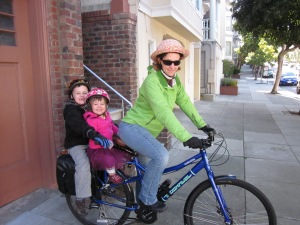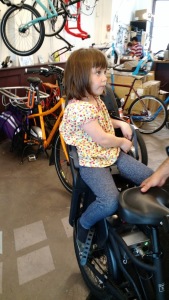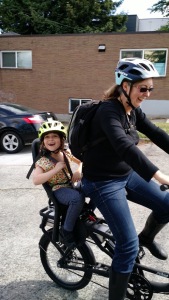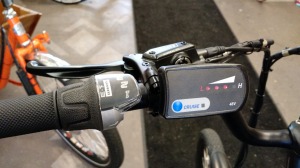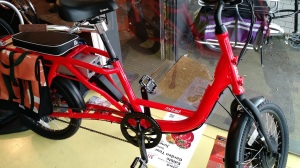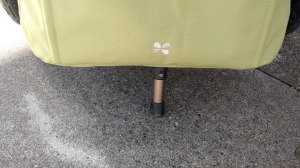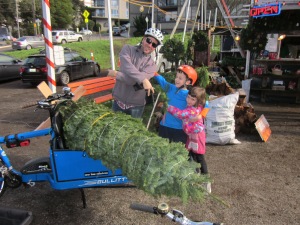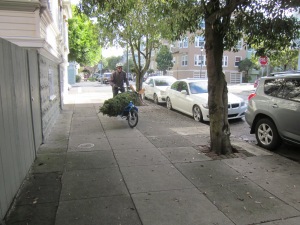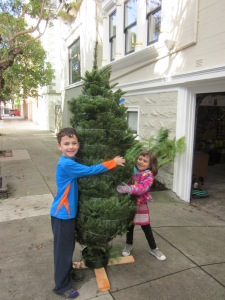I get asked questions about family biking a lot (Always welcome! Feel free to email! I will be painfully slow to respond, but it will happen eventually). One of the more common questions I get from people is where I think they should shop for bikes. This can be an awkward question to answer. There are thousands of bike shops and only one me. Admittedly there are far fewer family-oriented bike shops, but still. I live in San Francisco and mostly travel north from there, because that’s where my family lives. There’s no way that I could ever be truly objective, let alone offer advice to people in say, Minnesota.
That said, at least I have no conflicts of interest. I am a professor of public health and health policy at a university medical center with an extremely strict policy about any kind of giveaway that could be even vaguely construed as professionally-related. Although my primary work is in tobacco control, active transportation could easily be viewed as related to public health, because, well, it is in fact related to public health. Under the terms of my contract, I can’t be compensated for anything I say on this blog or accept any discounts or freebies (loaners are okay, but I have to give them back). So if nothing else it’s safe to say that my wildly subjective opinions are based solely on my wildly subjective experiences.
So anyway, below is a list of family-focused bike shops that I’ve liked and would visit again. It is a short list. First, as mentioned, I haven’t really visited THAT many bike shops, plus I only included shops that would actually call themselves family bike shops (which excludes our local bike shop). Second, I only listed places where we’ve made two or more purchases. My apologies to all the other family bike shops—I’m sure you’re great, but I have no way to know. Third, to the extent that you can trust anonymous reviews, they all get great reviews.
Shops are listed in order of their distance from my house. I admit that this is a totally useless organizing principle to anyone but me, but hey, it’s my blog.
Ocean Cyclery (1935 Ocean Avenue, San Francisco, California)
“The Enablers”
Family-friendly hit list
- Changing table in the bathroom: Not that I saw
- Kids’ play area: No, but noodling around on kids’ bikes is encouraged
- Customer seating suitable for nursing a baby: No
- Cargo bikes: Yuba (Mundo, Boda Boda)
- Assisted bikes: Yes, BionX both for the Yubas and as an after-market addition
- Kids’ bikes: Yes, and a buyback program to help afford bigger bikes as kids grow!
- Child seats: Yes, and a lot of expertise with them
- What we bought there: My old Breezer, Bobike Maxi, Bobike Junior, accessories, service
- Other: Ocean Avenue is a nice commercial strip with places to retreat when the kids get antsy, like the burrito shop next door. Transit access is excellent (it’s on the K line) and the former hippodrome around the corner is an outstanding place for test rides, especially for kids.
Ocean Cyclery is the first real family bike shop I ever visited, and they made it very easy to start biking for transportation. It is the shop where I often send people who ask me about different kinds of child seats, who want to buy bikes for their kids, and who tell me that they’re not sure they’re up for this “riding for transportation” thing that we’ve got going on but still want a bike, something inexpensive so they can ride with the kids on their new bikes in the park on weekends. Ocean has the widest selection I’ve seen in San Francisco of what I consider traditional family biking goods: child seats, trailers, and kids’ bikes. One Christmas they had a bike in the front window with a Bobike Mini on the front and a Bobike Maxi on the rear ready for test-rides, the only time I’ve ever seen such a thing in a bike shop. They offer a buyback program for kids’ bikes to make it easy to upgrade as your kids grow, and also have a great selection of bags and accessories. On the cargo bike side, they carry Yubas (assisted and unassisted). The owners, Jeff and Sabina, support the San Francisco Bicycle Coalition and they are incredibly nice. As a bonus, Ocean has possibly the best location for test riding bicycles in all of San Francisco: it is a block away from the city’s former hippodrome, which is now a sleepy flat oval road surrounded by homes. Even little kids can safely try out bikes there. If you’re interested in family biking but not sure where to start, Ocean Cyclery is your bike shop.

All the pretty assisted bikes live here.
The New Wheel (420 Cortland Avenue, San Francisco, California)
“The Curators”
Family-friendly hit list
- Changing table in the bathroom: No, but older kids will adore the tools and parts hung on every square inch of the bathroom walls; our son had to be forcibly extricated
- Kids’ play area: No; however younger kids can play with kids’ bikes and older kids will gravitate to the shop’s iPad
- Customer seating suitable for nursing a baby: No
- Cargo bikes: Xtracycle EdgeRunner
- Assisted bikes: All their bikes are assisted, and they will put after-market BionX assists on other bikes
- Kids’ bikes: Yes, plus, unusually, a good selection of helmets for infants
- Child seats: Yes, the Yepp rear seat
- What we bought there: Our son’s Torker Interurban (20”), Xtracycle EdgeRunner, our daughter’s helmet, BionX upgrades, accessories, regular service visits
- Other: Cortland Avenue is a quiet and increasingly upscale commercial strip so there are restaurants and shops, plus the Bernal Heights library about a block away if the kids lose patience. Getting there is a serious haul by bike but the 24 Muni line will drop you right in front of the shop.

The New Wheel comes out to Sunday Streets to offer test rides of assisted bikes, FYI.
The New Wheel is a focused bike shop. They carry only electric-assist bikes (okay, and unassisted kids’ bikes—it’s illegal for kids to ride assisted bikes in California). They’re actually even more focused than that: they carry extremely reliable assisted bikes that anyone can ride. The whole electric assist market is still pretty nascent, and has only recently become more than a private enclave for the do-it-yourself set. For someone new to the idea of riding a bike, let alone riding an assisted bike, the obsessive hobbyist end of the market can feel completely overwhelming, to put it politely. It felt that way to me. The New Wheel is not set up like a traditional bike shop, with mystifying parts and accessories piled up on every surface. Instead they have bikes in front to test ride, and some reasonably identifiable accessories mixed in with actual art. It is a very non-threatening place for a new rider to visit. If you want an electric-assist bike, you should go to The New Wheel. Their expertise with assist systems is in a class of its own. Plus, they always have the most recent BionX software upgrades and know how to tweak the system to maximize the torque for hill-climbing. They also reset our BionX so that it kicked in at 0.5kph instead of 2mph, which has been a total game-changer for us. Many of their commuter bikes have mid-drive assists, some of which could probably scale anything short of a vertical wall. Also, they have the prettiest assisted bikes, with none of the hulking beasts that anchor (literally) the less expensive and less reliable end of the market. In keeping with the curated feel, they offer one family/cargo bike: the EdgeRunner (assisted, obviously), as well as one kids’ bike in each size. Everything in their shop promises years of trouble-free riding. Brett and Karen, the owners, are kind people who have immense patience with my wild ideas, and they are also big supporters of the San Francisco Bicycle Coalition. Their service is top-notch, way beyond expectations (you can bring your unassisted bike here for service too). Because The New Wheel is an all-assisted bike shop, it is located in Bernal Heights, among the steepest hills in the city, including Bradford Street, with its 41% grade. That’s kind of inconvenient for me personally, but hey, why not?

There are so many bikes it’s tough to get a good shot.
Blue Heron Bikes (1306 Gilman Street, Berkeley, California)
“The Aggregators”
Family-friendly hit list
- Changing table in the bathroom: Uh, we didn’t visit the bathroom. Sorry.
- Kids’ play area: Yes, a Lego table in the back corner, plus an extensive collection of kids’ bikes that they’re encouraged to try
- Customer seating suitable for nursing a baby: No, although you can sometimes use the deck of a Bullitt for this
- Cargo bikes: Brompton, Bullitt, Surly, Xtracycle, Yuba, and more
- Assisted bikes: They carry assisted cargo bikes and will add after-market BionX kits to other bikes.
- Kids’ bikes: Yes
- Child seats: Yes, including the elusive Brompton Pere chair
- What we bought there: Brompton accessories
- Other: Gilman Street is a small commercial strip with some options for food and entertainment. The shop is right on the Ohlone Trail and easily accessible from North Berkeley BART.

The Lego table
A question I get a lot: “I want to try a lot of different kinds of cargo bikes. Is it worth traveling to Blue Heron in Berkeley?” My answer: Yes. Yes it is. They have all the bikes. They have cargo bikes I’d never seen or heard of before, and after the years I’ve spent obsessing about cargo bikes this is a rare experience for me. So if you want to compare riding a Bullitt with a Brompton with an Xtracycle with a Yuba with an odd-looking longtail that just came off a container ship from Japan, all in both assisted and unassisted versions, well, now you know where to go. It’s pretty obvious that Berkeley real estate is less expensive than San Francisco real estate, because they also have piles of commuter bikes and dozens of different kids’ bikes. As a result, Blue Heron Bikes is the Bay Area’s one-stop family bike shop. Even better, it is located along the Ohlone Trail, a shared bicycle-pedestrian path that runs past the North Berkeley BART station, and it has a large flat paved area in the back, which allows safe test rides for all ages. The owner, Rob, is passionate about family biking and patient with families who come in and are understandably a little overwhelmed with all the options they find. I’ve now met more than one family who bought a Bullitt there and made an adventure out of getting it back to San Francisco by ferry or BART, carving out an ad hoc Silk Road for family bicycles. Nonetheless, I feel resentful that Blue Heron is located in Berkeley and not in San Francisco.

Why not test ride in the shop itself?
Clever Cycles (900 SE Hawthorne Boulevard, Portland, Oregon)
“The Experts”
Family-friendly hit list
- Changing table in the bathroom: Yes, and diapers too. Like Ikea! But cooler.
- Kids’ play area: Yes, a large corner with a couch, toys, and books, plus kids’ bikes out the wazoo to try
- Customer seating suitable for nursing a baby: Yes
- Cargo bikes: Babboe, Bakfiets, Brompton, Metrofiets, Nihola, Surly, Workcycles, Xtracycle, Yuba, plus we spotted dark horses like the Kidztandem and Onderwater—seriously, it’s unreal
- Assisted bikes: They carry assisted cargo bikes and they developed and sell the Stokemonkey assist.
- Kids’ bikes: Yes
- Child seats: Yes, yes, yes
- What we bought there: rental bikes, accessories
- Other: Hawthorne Boulevard is a commercial strip featuring distressingly fast car traffic with some options for food and entertainment (basically a nearby bar as I remember it). Head back onto the nearby quiet and leafy streets of Ladd’s Addition for test rides instead.

Why not a hot tub?
Clever Cycles is the drag queen of family bike shops: it’s faaaaaaabulous! Honestly it’s difficult to describe, let alone oversell, Clever Cycles’ raw, unadulterated family biking appeal. I say this even though the first time I walked in, the bike at the front door had a huge growler full of beer attached to it. Honestly this seemed a little off to me for a family bike shop, but that is only because I do not live in Portland. Portland is so beer-crazy that I assume local hospitals give it away to new parents in lieu of formula. Clever Cycles is a venerable institution in the world of family biking, as its owners were importing, designing, and selling family bicycles and electric assists before we even had children. There was clearly unmet demand back then, because the shop has expanded through its various incarnations to the point that it’s now gigantic, at least to my eyes. It does not look like any other bike shop. It looks more like a bike museum (admittedly I have only visited one bike museum, in Davis, California). In the front showroom the box bikes look almost petite, and the kids’ bikes are parked in long rows on oriental rugs. There is so much space that the mechanical parts of the shop are tucked away in back, with rows of even more bikes. Their accessories are so extensive that I would embarrass myself with the omissions if I tried to give details. However they were the first U.S. shop to discover and carry the Brompton child seat, back when the idea of carrying a kid on a Brompton sounded roughly as plausible as throwing a kid all the way to the moon. In the realm of family biking I suspect they have accumulated more firsts than even they can remember. Clever Cycles has the largest selection of rental bikes that I have ever seen, including Bromptons and family trikes. The shop also rents out portable hot tubs that it delivers to customers by bike, because this is Portland. I mean, obviously. Unusually, Clever Cycles sells some clothing too. My only frustration with Clever Cycles is that it is so well-suited to its locale (as it should be) that it is rather less well-suited to mine. Nonetheless, at least one owner is a former resident of San Francisco, and so even if their stock doesn’t reflect our issues—it’s hard to imagine a shop making a go of selling unassisted bakfietsen in San Francisco, although one shop tried and moved to Sausalito—they have the expertise to speak intelligently about them. Even some of the offhand comments they made back in 2012, when we first bought our Bullitt, turned out to be more prescient than I had hoped (they were skeptical about adding the Patterson). At some point I realized that I was not totally ignorant about family bikes anymore, but I know enough to know my limits. The people running Clever Cycles are experts.

Bullitt line-up at Splendid Cycles
Splendid Cycles (407 SE Ivon Street, Portland, Oregon)
“The Visionaries”
Family-friendly hit list
- Changing table in the bathroom: Uh… once again we neglected to check the bathroom.
- Kids’ play area: Yes, a corner with a bench and a basket of books and toys
- Customer seating suitable for nursing a baby: Yes, plus the deck-of-a-Bullitt option
- Cargo bikes: Bullitt, Butchers & Bicycles, Xtracycle
- Assisted bikes: They carry assisted cargo bikes.
- Kids’ bikes: No
- Child seats: Yes, various options for the Bullitt and Yepp seats for the Xtracycle
- What we bought there: our Bullitt, rental bikes, Bullitt parts and accessories
- Other: Splendid Cycles is located on a weird little corner underneath the freeway and near some industrial/construction companies, which I offer as a warning because when we first got there, we thought we were in the wrong place. The shop is also directly adjacent to a lovely bike path that runs along the river. Portland, I sometimes find you kind of schizo. Who zones this way?

The kid zone
I first visited Splendid Cycles after we realized that we might actually be able to stop using our car in San Francisco if we had the right bike. The BionXed Big Dummy that they had available for test rides was the first assisted bike that I ever rode, and after hauling my extremely patient friend Todd on its deck up the hills around the shop I couldn’t stop grinning and thinking, “This could totally work!” Joel and Barb, the owners of Splendid, imagined a world full of crackpots like me and decided they could help make it happen. And so they did something that I would never have the courage to do: they opened a shop that sold only cargo bikes. And holy smokes, they were right: there really were a lot of crackpots like me out there. Splendid is best known for selling Bullitts (and in fact it serves as the source for all the Bullitts sold in the family bike shops we visit, as it imports them). But there are lots of good reasons to ride longtails as well, and Splendid had child seats on Big Dummies long before the EdgeRunner made its debut in less forward-thinking shops. They rent bikes as well, which is very helpful when learning to maneuver cargo bikes—in some cases (mine) there is a learning curve. I’m still awed by the sheer bravado involved in opening up a bike shop that doesn’t carry any “normal” bikes, but you’d never guess it was anything out of the ordinary from talking to Joel and Barb, who are down to earth and incredibly helpful and also know way more about cargo bikes than, like, everybody. When they started their shop cargo bikes were pretty much a boutique niche and everything was somewhat customized. The rain cover for the Bullitt was their development, and getting it made riding with our kids in all weather conditions completely unremarkable. Both the covers and the larger wooden boxes that hold more kids are accessories they developed with local Portland businesses. When we bought our Bullitt we had the option of getting a larger wooden box but declined in favor of the standard box both because we couldn’t get a rain cover for the wooden box and because we wanted a narrower bike. Not long after that, they’d developed rain covers for the larger wooden boxes and now they have 3-child Bullitt boxes and rain covers for those too. They are already selling Bullitts with the super-powered BionX D on them, which is not an option yet here in San Francisco, no matter how often I call. (One of the problems of being an early adopter is that now I’m always envious of the latest innovations.) They never stop coming up with new cool things, many of which are so popular that they stop being innovations. Then they put the only-slightly-less-cool older bikes on the incredible sale page of their website. Honestly, I didn’t really catch on to how impressive it all was at first because Joel and Barb are so mellow. They put their bike shop on an industrial corner and concentrate on the bikes rather than the bling. Splendid has all the right things without any unnecessary extras, and they are always coming up with more awesome ideas that make family biking (and the somewhat-less-interesting-to-me cargo biking) easier and more fun. Whenever there is discussion about adding bike lanes in San Francisco, there is always blowback from some people about how it’s only for hipsters, and that you can’t shop for groceries or carry kids on a bike. These people are wrong. Splendid Cycles is building a world where people can carry anything and everything on bikes.

The G&O logo is a family bike.
G&O Family Cyclery (8417 Greenwood Avenue N, Seattle, Washington)
“The Tinkerers”
Family-friendly hit list
- Changing table in the bathroom: Yes
- Kids’ play area: Yes, a train table right in front, plus some balance bikes that kids can ride
- Customer seating suitable for nursing a baby: Yes, stools by the counter (and the deck of a Bullitt), not to mention a La Leche League sticker in the front window
- Cargo bikes: Brompton, Bullitt, Metrofiets, Soma Tradesman, Surly Big Dummy, Xtracycle
- Assisted bikes: They carry assisted cargo bikes and will add after-market BionX, Bafang, or Stokemonkey kits to other bikes.
- Kids’ bikes: Cleary bikes (all sizes), Soma BART
- Child seats: Yes, including the elusive Brompton Pere chair (in stock!)
- What we bought there: Brompton parts and service, Xtracycle EdgeRunner accessories (frame-mounted front rack, Rolling Jackass center stand)
- Other: Greenwood Avenue has great options for food and entertainment when the kids start to lose it, including the Greenwood Space Travel Supply Company (formerly the Seattle outpost of 826 Valencia)

The train table
G&O stands for Tyler Gillies and Davey Oil, and while their shop is less than two years old, I knew Davey well before then, when he had his own blog, Riding on Roadways (now folded into the shop blog). I love G&O because it has and does all the things that people learn they want once they start riding around with kids. It’s a bike shop that grew out of family biking. Almost all the bike shops we visited when we first started riding talked about family biking as something extra, “oh yeah, we’ll do that when we have time, later.” In most cases, of course, later meant never, but even shops that pick up family biking sometimes do it half-heartedly. But not here! This is a shop that had a changing table in the bathroom and a La Leche League sticker on the front door the day that they opened, and that puts the kids’ play table right out in front with the bikes. You can tell when you walk in the door that no one is going to freak out about your trying out a Yepp seat by actually putting a kid in it, something that happened to us (twice, in fact). G&O has launch parties when customers come to pick up their new bikes. They make a point of keeping accessories in stock that don’t necessarily make money, like the Brompton child seat, because “why should you have to wait for us to order it?” You want obscure kid-hauling stuff, like a helmet sized for a toddler? They’ve got your back. Despite the huge increase in family biking lately, things like toddler helmets are in fact considered obscure, and cargo bikes don’t necessarily have all the things families want yet. I think of Davey and Tyler as tinkerers because I know that there is nothing you can dream up that they won’t try to make work, as long as it’s safe. When I visited their shop last year, they were installing a Yepp mini front seat on a giant mountain bike with a telescopic fork, and the whole rig was covered in mud. It was the weirdest combination I’d seen in a while, and I stopped dead and said, “Really?” And Tyler smiled and said, “It’s what they want.” That visit to G&O is also where I found the frame-mounted front rack that now graces my EdgeRunner (maybe grace is the wrong word there, I concede that it’s not pretty), when I test rode Davey’s own personal EdgeRunner, which has the same rack. G&O also tested the first true pedal-assist Stokemonkeys, and have put more kinds of assist systems on a Bullitt than I knew existed. And of course they’ll take care of non-family bikes too. Servicing family bikers is like building for accessibility—what’s good for people in wheelchairs is good for everybody, and what’s good for families on bikes is good for all riders. Seattle is lucky to have G&O.
























